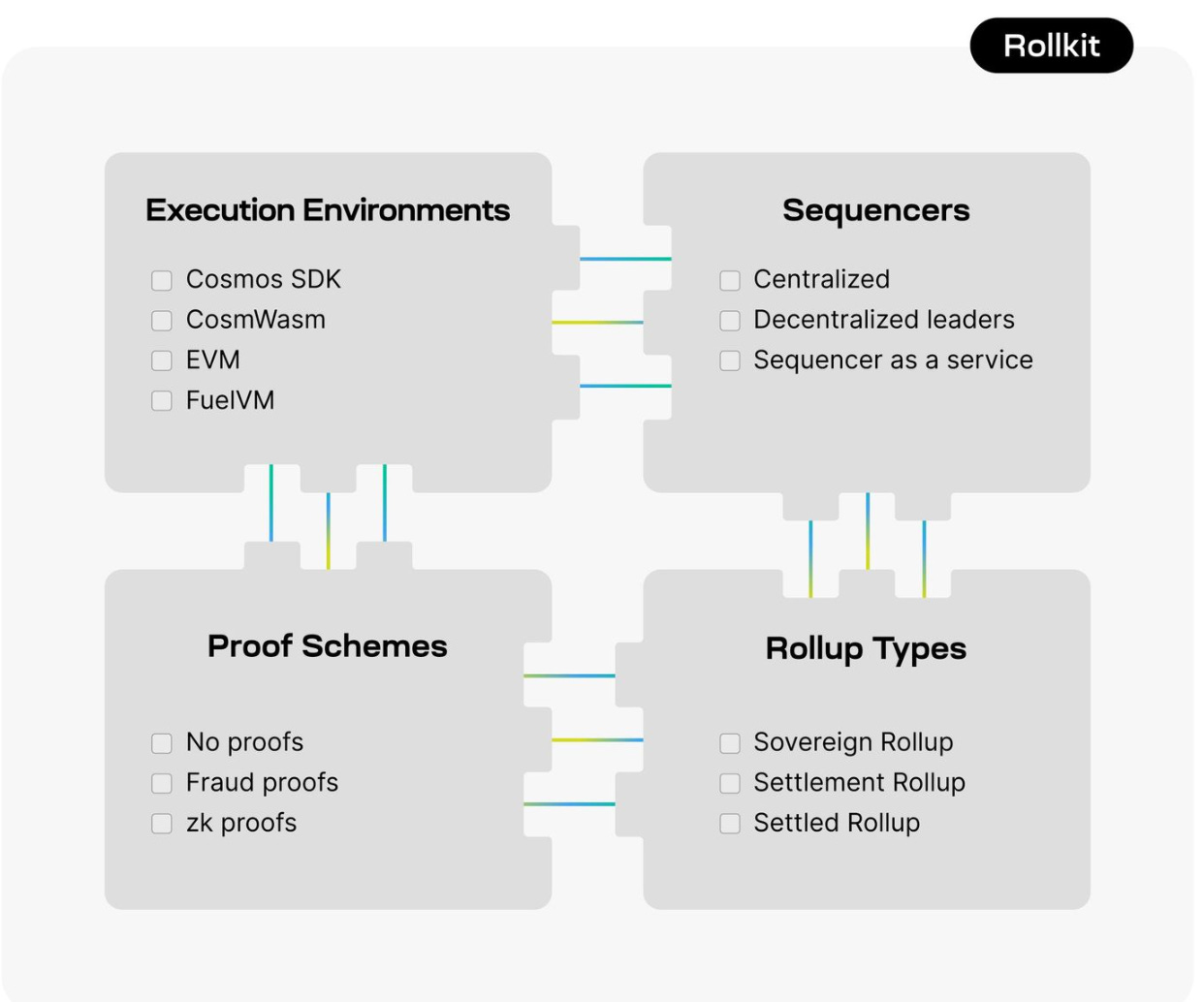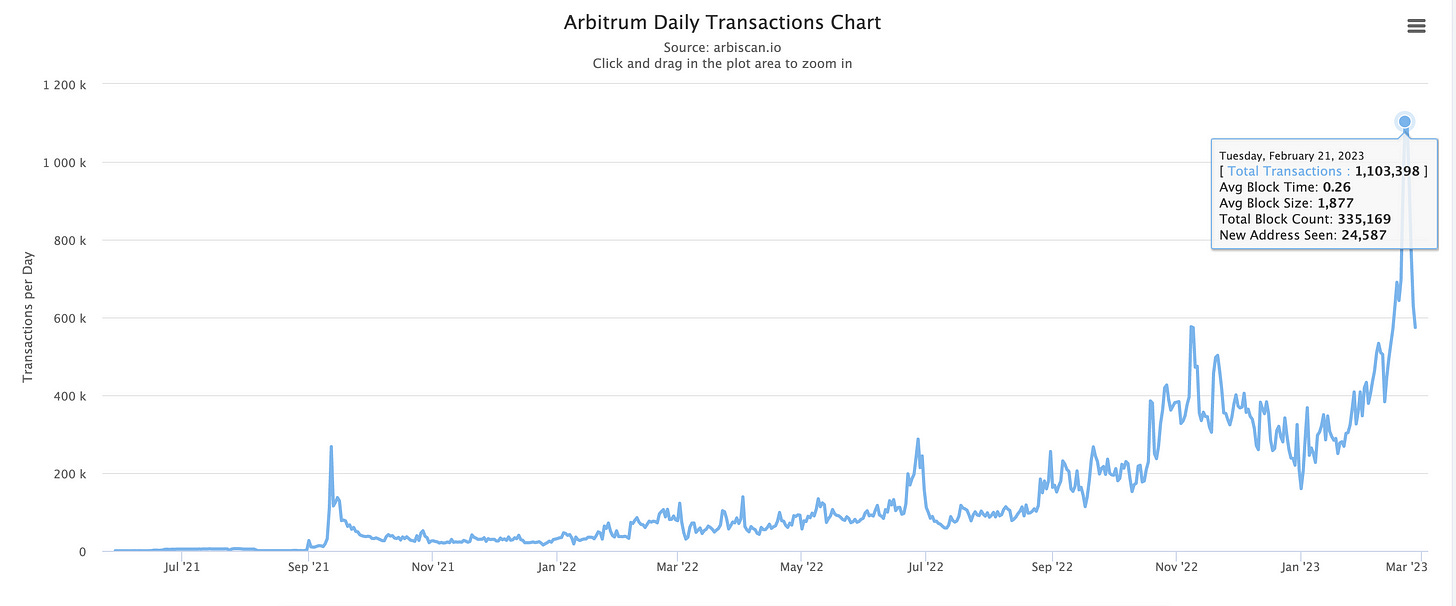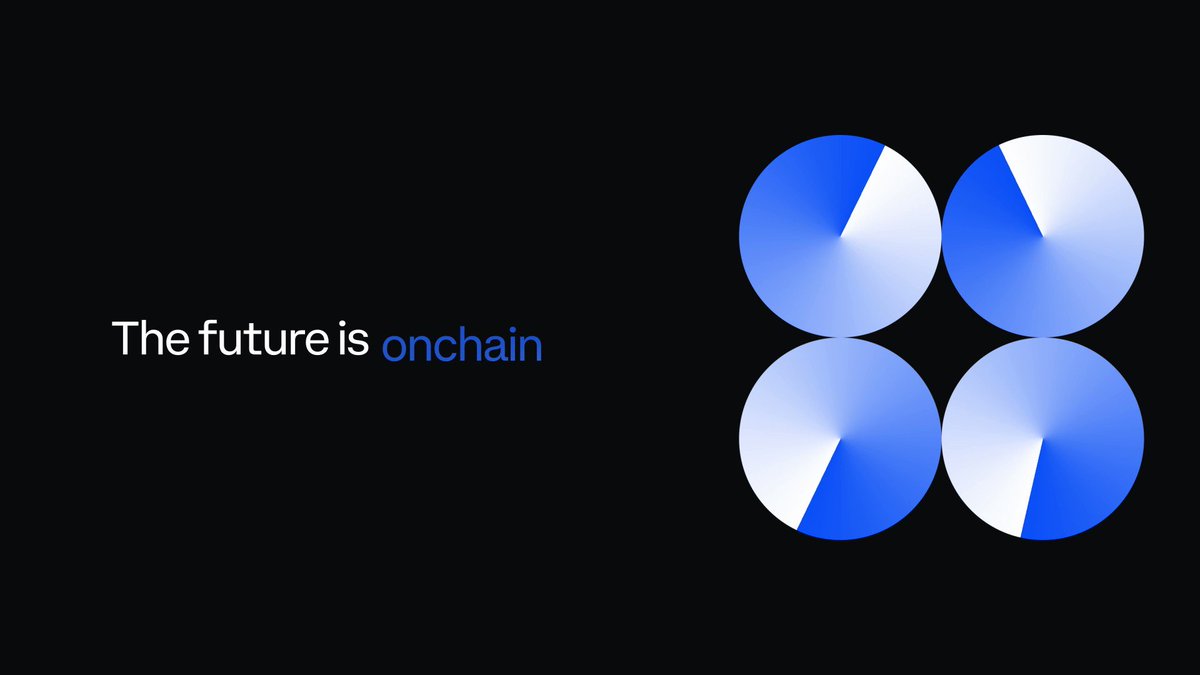Weekly Rollup #3
For the week ending February 24th
Welcome to Modular Media, a weekly newsletter covering news, updates, educational content, and more within the modular ecosystem.
Subscribe to get issues sent directly to your email every Tuesday, and also, make sure to follow us on Twitter for daily modular updates!
You can check out our previous newsletter issue here.
📣 News and Announcements
Coinbase Announces Base
Last week, Coinbase announced the testnet launch of Base, an Ethereum L2 built using the OP Stack, which is a set of software tools used to build within the Optimism ecosystem.
Not only is this the first publicly traded company to launch its own blockchain, but this announcement also helps validate the rollup thesis - we now have the biggest company in the entire space building its own L2 network!
Just as Coinbase made it easy for users to buy crypto, they now want to make it seamless for their customers to get on-chain and take advantage of all the cool DeFi protocols. Their goal is to take people from a blockchain-centric focus, to a dapp-centric one. The users shouldn’t have to know which chain they're on, or what native gas token to use, they should just worry about whether or not they want to use the dapp.
Here are some of the features Base will have to offer:
Ethereum Security: As mentioned earlier, Base is built using Optimism’s OP Stack, keeping them within the Ethereum ecosystem .
Empowered by Coinbase: Base will be completely open and permissionless, allowing any team to leverage the platform’s 100M+ customer base, along with their products and tools, such as Coinbase Wallet.
Big features, small fees: “full EVM equivalence at a fraction of the cost”
Open source: building everything open source
On top of all this, Base will not have its own native gas token, instead, it’ll be using ETH.
According to the team, they’re building Base on the OP Stack, “with the vision of creating a standard, modular, rollup agnostic Superchain powered by Optimism.”. Optimism’s Superchain aims to become a unified network, or “mesh”, of multiple interoperable L2 networks, all built using the OP Stack and all working together.
In the coming weeks, the Base team will be sharing their road to mainnet, so make sure to follow them on Twitter if you want to stay in the loop.
Introducing Rollkit
Last week, the Celestia team introduced Rollkit, a modular rollup framework that enables developers to pick and choose between different features in order to build their own custom rollup.
Rollkit (previously Rollmint) has been in development by the Celestia team since 2021 but has now been introduced as its own neutral project, independent from Celestia.
Think of the Cosmos stack, which consists of the Tendermint consensus engine, an app layer, and ABCI, which is a tool used to convert dapps written in different programming languages into one that is compatible with Tendermint.
Rollkit replaces Tendermint.
Specifically, Rollkit is a sequencer node that is used to publish data to Celestia. So the rollups built with Rollkit will take care of their execution, and then use the rollkit sequencer to communicate with the DA layer.
And since Rollkit and Celestia are independent from one another, you can tell this sequencer node which DA layer to connect to, whether you want that to be Celestia or a different solution.
With Rollkit, developers will have the power to choose and switch between different execution environments, sequencers, proof schemes, and rollup types.

Image Source
It’s important to note however that not all of these features have been added yet. According to the team, “Rollkit is in an early stage of development and many features remain to be built to reach this vision. In its current state, Rollkit rollups are sovereign rollups with single sequencers, with support for a pessimistic mode and a work-in-progress optimistic mode.”
For anyone wanting to see a PoC, @dferrersan, a Celestia engineer recently ran a sovereign rollup that uses the FuelVM as an execution environment by leveraging Rollkit. You can read all about that here.
You can also check out the full article to learn more about Rollkit, and for any developers interested in experimenting today, you can start building with Rollkit on Celestia’s Mocha testnet.
Eclipse x Polygon: Introducing Polygon SVM
On February 23rd, Eclipse & Polygon announced Polygon SVM, an L2 blockchain that combines some of the strongest features from the Solana and Polygon networks.
To recap, Eclipse lets developers combine their favorite parts of different blockchains to create their own dedicated, custom rollup. So rather than having to build on top of a generalized rollup (dapps living together on the same chain), teams can instead have their own dedicated rollup.
Eclipse enables builders to choose their preferred virtual machine (Ethereum VM or Solana VM), and preferred data availability layer (Celestia, Polygon Avail, Eigen DA), along with whatever other customizations they think are best for their specific rollup. This could be using the chain’s own native gas token, adding privacy features, MEV options, and more.
So what is Polygon SVM?
Here’s a breakdown of the different modular components within this Polygon SVM stack:
Settlement Layer: Eclipse
DA Layer: Polygon Avail
Execution Layer: Teams can build their own execution environment on top of Polygon SVM, using Solana’s high throughput virtual machine
Polygon SVM combines Solana’s Sealevel virtual machine, with Polygon Avail, Polygon’s own data availability solution.
Developers will be able to build their own custom rollup on top of Polygon SVM, allowing them to remain within the Polygon ecosystem (access to EVM tools & wallets, Polygon users, dapps, etc.), while leveraging the high throughput of Solana’s VM.
Specifically, these rollups will use the Sealevel VM to execute transactions, then post the blocks of data to Polygon Avail. Of course, Eclipse remains as the settlement layer, responsible for bridging and passing proofs that are received from the execution layer.
As of today, Eclipse has ten partnered projects that will be announcing their launch over the next several weeks. Polygon SVM was just the first of ten to be announced and is expected to launch on testnet during Q1, with mainnet release expected for this upcoming summer.
Make sure to follow Eclipse on Twitter to stay up to date with all their future announcements.
Arbitrum Surpasses Ethereum Mainnet in Transactions Processed
It was a huge week for the Arbitrum community, as for the first time ever, the Arbitrum network processed more transactions than Ethereum mainnet, becoming the first rollup to accomplish this feat.
On February 21st, Arbitrum processed slightly over 1.1M transactions within that 24-hour span, which was about 20,000 more than Ethereum mainnet.

Aside from processed transactions, Arbitrum also saw a rise in the number of active addresses, a rise in bridged ETH, along with an increase in TVL throughout the year.
Many believe this rise in activity is due to the network’s upcoming airdrop, however, with popular dapps like Gains (GMX), along with strong commmuntites like that of TreasureDAO, one could make the assumption that a lot of this growth has been organic.
Arbitrum is an L2 optimistic rollup deployed on top of Ethereum. Projects & dapps can deploy on top of Arbitrum to take advantage of high speeds and lower fees, while still being able to benefit from Ethereum security.
More News & Updates
Attention developers, Arbitrum just released a new version of their SDK (3.1.0)
Fuel Labs will be co-hosting a hackathon from March 10-29, including $125K in prizes
Check out Fuel Labs’ latest edition of “Inside Fuel”, an article series that takes you through some of the biggest, recent developments within the Fuel ecosystem
The BitDAO community just passed a proposal to provide funding to Mantle, to help them continue to develop their network over the following months
Risc Zero recently released a repo and a whitepaper highlighting details of their proof system. You can check out the details about that in this thread.
Ethereum’s KZG Summoning Ceremony surpassed 50K contributions
Saga announces a strategic partnership with Onenet, a video game distribution & showcase platform
Here’s an in-depth thread going over Celestia, the first modular network
EigenLayer, a protocol that is re-distributing Ethereum security, just released the first public version of their whitepaper - we’ll have a summary about this done for you soon!
Arkham, a data & insights platform, officially integrates the Polygon network
Timeswap launches v2 on Polygon mainnet - here is what this new version adds.
Looks like Compound v3 is coming to Polygon mainnet
Polygon zkEVM testnet upgrade is coming next week, featuring support for Etherscan, and FFLONK (universal trusted setup)
Next week, StarkNet will upgrade StarkNet Goerli to SHARP 4.0
Here’s an article covering android app development for StarkWare, developed by the Crypto Mansion team, who build tools for the StarNet community
A StarkNet builder just released a PoC of a substrate based StarkNet sequencer
zkSync announces collaboration with Sygnum Bank, a crypto-native regulated bank
Check out the details for zkSyncs upcoming hackathon, featuring a $25K prize pool - running from now until March 19th
Check out the Scroll team's latest “Weekly Update” thread, this week featuring an Aave deployment
📚 Discussions and Education
Coinbase Rollup Good or Bad?
Most people in the Ethereum community seem excited over the Coinbase announcement, but Ethereum developer @lightclients challenges the idea that Base is good for the ecosystem.
Their main points are:
A separate rollup means extra bridge and UX complexity
Bridges and UX are hard enough already
Why not just use Optimism mainnet?
The points are reasonable, as no one will argue that bridges and UX are easy. If Coinbase simply used Optimism mainnet, these would be non-issues.
Here’s what the OP Labs team thinks:
There are good reasons to run a separate rollup, citing common appchain arguments like custom gas and token economics.
Because Base is part of the Superchain, they will benefit from unified bridge designs and mitigate bridge complexity. It also makes sense for Base to customize UX around their distribution channel and users - so this complexity is worth it.
Ryan Berckmans also weighs in with a comprehensive take on why Base makes sense and how we’ll solve the design challenges. He starts by emphasizing something we at Modular Media believe whole heartedly - one chain CANNOT do it all:
If you buy this notion, the conversation shifts to how we’ll solve the bridging and UX challenges (vs. whether we should try). He touches specifically on the bridging topic.
In the OP Twitter Space, Coinbase makes clear they will be progressively decentralizing the sequencer. But let’s assume they don’t. Ryan explains why a centralized Base would still be valuable and capable of trust-minimized bridging to separate rollups like Optimism mainnet and even StarkNet - using an NFT bridge example.
Takeaway: Coinbase rollup good 👍
Question: Is this the start of a larger trend? 👀
Did Cosmos Miss its Window?
Everyone knows that Cosmos pioneered the appchain narrative. The question is - did Ethereum hijack it? Will all appchains be built as Ethereum rollups?
Vance from Framework Ventures thinks so, but others disagree. Let’s review different takes.
@0xshake is part of Polymer Labs, pioneering ZK-IBC for Cosmos appchains, so it’s unsurprising that they disagree with the idea of Ethereum dominance. Their meme is appchains = innovation, L2s = scaling. If that’s the case, it certainly doesn’t sound like Ethereum L2s will eat everything. We need innovation!
This meme might not be all that accurate, though. Innovation is possible at L2. For example L2s can use different execution environments - Toghrul from Scroll explains how this works.
But does @0xshake have a point? Are there limitations to L2 innovation?
Yes. As usual, it’s a spectrum. And there are even points along that spectrum in between Ethereum L2s and Cosmos L1s:
Ethereum L2s
Sovereign rollups on Celestia
Middleware on EigenLayer
Cosmos L1s
Which designs will win the majority of use cases? TBD (sorry).
Can ZK Provers Keep Up?
Anatoly expresses skepticism over ZK L2s, saying they aren’t performant enough to be scalability solutions. What does he mean? Where is this coming from?
Solana’s goal is to synchronize global state at the speed of light, and Anatoly maps everything to that goal. His argument is that it’s impossible for a ZK prover to be as fast as real-time execution, and therefore it’ll always lag behind chain finality and be unhelpful.
Let's assume he is technically right. Practically, he’s still definitely wrong.
The ZK gigabrains are on the same page and make this clear:
Basically, it doesn’t matter if one ZK prover lags behind execution. You can solve the problem by having many ZK rollups running in parallel.
And ZK provers might have even more tricks up their sleeves 🤯
More Discussions & Education
OP Labs hosts a Twitter Space discussion about building Base on the OP Stack with @jessepollak
@kelvinfitcher explains Optimism’s vision for the Superchain
@jessepollak clarifies that Base will let users pay fees in whatever token they want
@jon_charb writes an article outlining better ways to think about blockchain profitability
Bankless releases a podcast episode with @job_charb, discussing his article 👆
@yezhang shares lessons learned from building the Scroll zkEVM
@zooko shares his thoughts on Scroll’s zkEVM work 👆
@jiayaoqi illustrates the past few years of building AltLayer and scaling blockchains
AltLayer hosts a discussion about all things Layer 2 with @dberenzon
@Cryptocito hosts a discussion about the endgame for shared security with @nickwh8te and @sunnya97
Bell Curve releases a podcast episode on rollapp stacks with Sovereign Labs and Slush
@gluk64 explains the rollup security trilemma and how zkSync solves it
@LeThang137 summarizes the shared security discussion 👆
@seppwurscht summarizes Mesh Data Availability, a concept introduced by @sunnya97 in the shared security discussion 👆👆
Celestia hosts a Twitter Space discussion about MEV in the modular stack with builders from Skip Protocol, Duality and Astria
@stonecoldpat0 writes an article explaining the tiers of transaction finality for rollups
@eclecticcapital writes an article exploring MEV in the Solana and Cosmos ecosystems
@toghrulmaharram joins Solana’s Validated podcast to discuss rollup and ZK proofs
Celestia depicts Rollkit’s long-term vision
Eclipse explains sovereign rollups in simple terms
Hyperplane explains synergies between them and EigenLayer
@toghrulmaharram explains DA trust assumptions and why there’s low risk of DA failure
Saga hosts a Twitter Space discussion about building web3 games on dedicated blockspace
@sreeramkannan clarifies that EigenLayer is highly complementary to rollups
@0xSalazar explains how zkEVMs interact with base layer Ethereum in simple terms
@toghrulmaharram distinguishes between sovereign rollups and L2s
@arjunbhuptani explains the differences between L1<>L1 and L2<>L2 bridging
@terencechain shares notes from the EIP-4844 implementer call
@NoahCitron explains that if an optimistic rollup doesn’t need withdrawals (likely many use cases), it also doesn’t need a fraud proof mechanism and can still inherit DA benefits
@nosleepjon explains how Hyperplane fits into Optimism’s Superchain vision
@WestieCapital explains how Danksharding allows synchronous composability between the L1 and ZK rollups, so liquidity is not fragmented
@toghrulmaharram explains that it’s not possible to use two chains for rollup settlement
That's all for this week! Thanks for reading 🧱🎬



 We’re excited to announce
We’re excited to announce 
 11.6K
11.6K
















